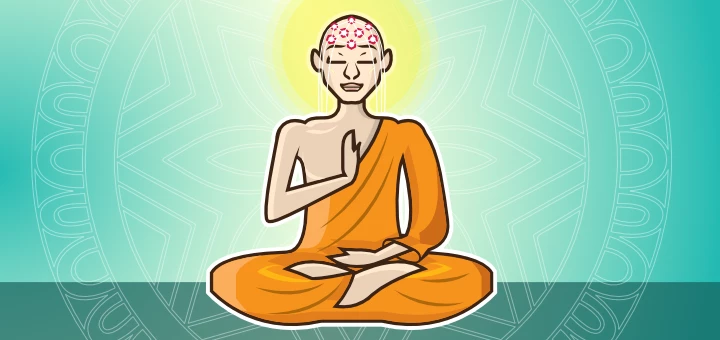Your Brain on Meditation: Using Yoga’s Limbs to Achieve Pure Awareness

In 2004 one scientific study made quite a splash. In this study, the scientists had monitored the brain activity of eight Tibetan monks and recorded very high-frequency gamma waves that became dominant in states of deep meditation.
Previous studies have demonstrated that gamma waves are present during mental processes such as attention, working memory, learning, or conscious perception. “Gamma oscillations have been proposed to act as an integrative mechanism that may bring a widely distributed set of neurons together into a coherent ensemble that underlies a cognitive act.”(1)
Gamma waves show up in both waking and dreaming states, but usually in those states, the gamma-band activity is desynchronized. Yet during the states of deep meditation, the brains of experienced practitioners had exhibited amazing gamma synchrony. This is important because “long-distance synchrony is thought to reflect large-scale neural coordination. […] Long-distance synchrony increases by ≈30% on average during meditation.”(2)

What is remarkable about this is that we tend to think of meditation as a peaceful state, and would probably guess that in a state of deep meditation the brain waves were likely to be slower and quieter, similar to deep sleep states. It turns out that the opposite is true. The brain waves during meditation are of higher frequency than during all other conscious states, including both waking and dreaming states. It is as if the brain is highly aware of the experience but is not disturbed by it. Might this be the state of “superconsciousness” or “pure consciousness” that Mandukya Upanishad talks about?
Object-Based vs. Objectless Meditation
Another interesting distinction that the study made was between object-based and objectless meditation. It showed that the brain waves during deep loving-kindness meditation (objectless meditation) were different from object-based meditation (when you focus your attention on something specific, which in yoga we call “one-pointedness”).
“Objectless meditation does not directly attend to a specific object but rather cultivates a state of being. Objectless meditation does so in such a way that, according to reports given after meditation, the intentional or object-oriented aspect of experience appears to dissipate in meditation. This dissipation of focus on a particular object is achieved by letting the very essence of the meditation that is practiced (on compassion in this case) become the sole content of the experience, without focusing on particular objects. By using similar techniques during the practice, the practitioner lets his feeling of loving-kindness and compassion permeate his mind without directing his attention toward a particular object. These phenomenological differences suggest that these various meditative states (those that involve focus on an object and those that are objectless) may be associated with different EEG oscillatory signatures.” (2)
The Sixth, Seventh and Eighth Limbs of Yoga
This description of object-based and objectless meditation sounds remarkably similar to the three stages of meditation defined in the yoga tradition. According to yogic teachings of meditation, at the beginning of your meditation exploration, it is useful to pick an internal or external object to focus on. This object serves an important purpose of training your focus and teaching you to be able to concentrate on one thing for an extended period of time (developing one-pointed focus). Later on, as the practitioner becomes more experienced, the object of meditation serves more as a gateway to the meditative state of being. Those ideas are described in the Yoga Sutras of Patanjali as three stages of meditation: dharana, dhyanam, and samadhi.
First Step: Dharana
Dharana (-dha- “to hold”) means being able to hold attention on an object for progressively longer periods of time without distraction. For example, you can hold your attention on the light of a candle, or the  rhythm of your breath for an extended period of time.
rhythm of your breath for an extended period of time.
Second Step: Dhyanam
Dhyanam (-dhi- “to reflect”) occurs when there begins to be a relationship between the mind and the object of attention. It means that you gain some insights about yourself from concentrating on the object.  For example, by meditating on an image of fire in your belly you gain insights about your ability to process your experiences.
For example, by meditating on an image of fire in your belly you gain insights about your ability to process your experiences.
Third Step: Samadi
In the state of Samadhi the relationship between the object and the mind becomes very close, as if they have merged. At that point the mind begins to shed its  conditioning and the object shines forth as it is. It is as if you take on the qualities of an object, become it.
conditioning and the object shines forth as it is. It is as if you take on the qualities of an object, become it.
At that point, according to Patanjali, instead of being clouded by your baggage, the mind becomes like a transparent crystal, able to reflect the object perceived, the instrument of perception (the mind) and the process of perception. It sounds as if Samadhi is a gateway to the state of Turya (pure consciousness) that might be manifested in high-frequency, synchronous gamma brain waves.
Transcending the “Me” States
In our normal daily life we continuously cycle through three stages of consciousness: waking state, dreamless sleep, and dream state. All of those three states are about “me, me, me”—assessing everything that comes into your awareness through the lens of its relevance to you. This is a normal brain activity that prioritizes your survival and well-being. However, according to both the Buddhist and the yogic traditions, all this concern with self is contained within a wider pool of pure awareness. “In particular, awareness does not need a self to operate. Aspects of self-arise and disperse within awareness, but awareness persists as a field of consciousness independent of the vicissitudes of self.” (3)
If you are interested in experiencing this state of pure consciousness beyond the “me, me, me” concerns, you can get there through the stages of dharana-dhyana-samadhi (object-based meditation). Over time this leads to the state of turya. Or you can bypass the work of object-based meditation and instead focus on cultivating the state of loving-kindness right away (which is considered to be your natural state of consciousness in Buddhist tradition).
In yoga this is called ishvara pranidhana. Yoga Sutra 1.23 states that another way to experience your true nature (the state of pure consciousness), is through a special process of devotion and letting go into the creative source from which we all emerged. However, both the states of loving-kindness and ishvara pranidhana are not easy to just fall into for most of us. It usually requires extensive training. For most of us going the dharana–dhyana-samadhi route is more doable.
Reprinted with permission from Sequence Wiz.
 Educated as a school teacher, Olga Kabel has been teaching yoga for over 14 years. She completed multiple Yoga Teacher Training Programs but discovered the strongest connection to the Krishnamacharya/ T.K.V. Desikachar lineage. She had studied with Gary Kraftsow and American Viniyoga Institute (2004-2006) and received her Viniyoga Teacher diploma in July 2006 becoming an AVI-certified Yoga Therapist in April 2011. Olga is a founder and managing director of Sequence Wiz- a web-based yoga sequence builder that assists yoga teachers and yoga therapists in creating and organizing yoga practices. It also features simple, informational articles on how to sequence yoga practices for maximum effectiveness. Olga strongly believes in the healing power of this ancient discipline on every level: physical, psychological, and spiritual. She strives to make yoga practices accessible to students of any age, physical ability and medical history specializing in helping her students relieve muscle aches and pains, manage stress and anxiety, and develop mental focus.
Educated as a school teacher, Olga Kabel has been teaching yoga for over 14 years. She completed multiple Yoga Teacher Training Programs but discovered the strongest connection to the Krishnamacharya/ T.K.V. Desikachar lineage. She had studied with Gary Kraftsow and American Viniyoga Institute (2004-2006) and received her Viniyoga Teacher diploma in July 2006 becoming an AVI-certified Yoga Therapist in April 2011. Olga is a founder and managing director of Sequence Wiz- a web-based yoga sequence builder that assists yoga teachers and yoga therapists in creating and organizing yoga practices. It also features simple, informational articles on how to sequence yoga practices for maximum effectiveness. Olga strongly believes in the healing power of this ancient discipline on every level: physical, psychological, and spiritual. She strives to make yoga practices accessible to students of any age, physical ability and medical history specializing in helping her students relieve muscle aches and pains, manage stress and anxiety, and develop mental focus.
References
-
Rodriguez, E., George, N., Lachaux, J., Martinerie, J., Renault, B., & Varela, F. J. (1999, February 04). Perception’s shadow: Long-distance synchronization of human brain activity. Retrieved from https://www.nature.com/articles/17120
-
Lutz, A., Greischar, L. L., Rawlings, N. B., Ricard, M., & Davidson, R. J. (2004, November 16). Long-term meditators self-induce high-amplitude gamma synchrony during mental practice. Retrieved from http://www.pnas.org/content/101/46/16369
-
Hanson, R., & Mendius, R. (2010). Buddha’s Brain: The practical neuroscience of happiness, love & wisdom. Sydney, Australia: ReadHowYouWant.



